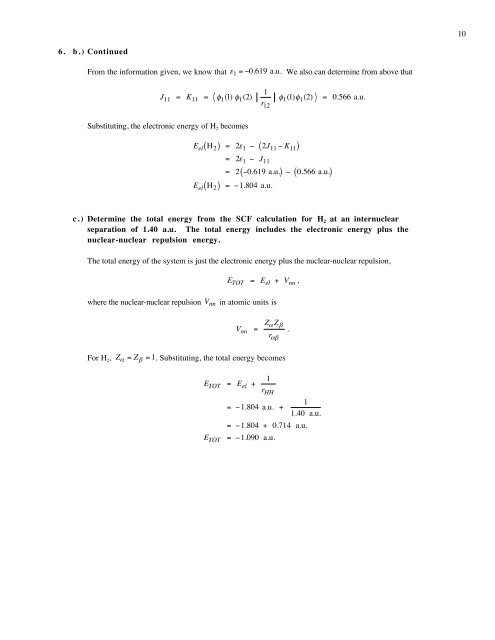Create successful ePaper yourself
Turn your PDF publications into a flip-book with our unique Google optimized e-Paper software.
10<br />
6. b.) Continued<br />
From the information given, we know that ε 1 = −0.619 a.u. We also can determine from above that<br />
J 11 = K 11 = φ 1 (1) φ 1 (2)<br />
€<br />
1<br />
r 12<br />
φ 1 (1)φ 1 (2) = 0.566 a.u.<br />
Substituting, the electronic energy of H 2 becomes<br />
€<br />
( ) = 2ε 1 − ( 2J 11 − K 11 )<br />
E el H 2<br />
= 2ε 1 − J 11<br />
= 2 −0.619 a.u.<br />
( ) − ( 0.566 a.u. )<br />
( ) = −1.804 a.u.<br />
E el H 2<br />
c.) Determine the total € energy from the SCF calculation for H 2 at an internuclear<br />
separation of 1.40 a.u. The total energy includes the electronic energy plus the<br />
nuclear-nuclear repulsion energy.<br />
The total energy of the system is just the electronic energy plus the nuclear-nuclear repulsion,<br />
€<br />
E TOT = E el + V nn ,<br />
where the nuclear-nuclear repulsion V nn in atomic units is<br />
€<br />
V nn = Z α Z β<br />
r αβ<br />
.<br />
€<br />
For H 2 ,<br />
Z α = Z β = 1. Substituting, the total energy becomes<br />
€<br />
E TOT = E el +<br />
1<br />
r HH<br />
= −1.804 a.u. +<br />
1<br />
1.40 a.u.<br />
= −1.804 + 0.714 a.u.<br />
E TOT = −1.090 a.u.<br />
€

















